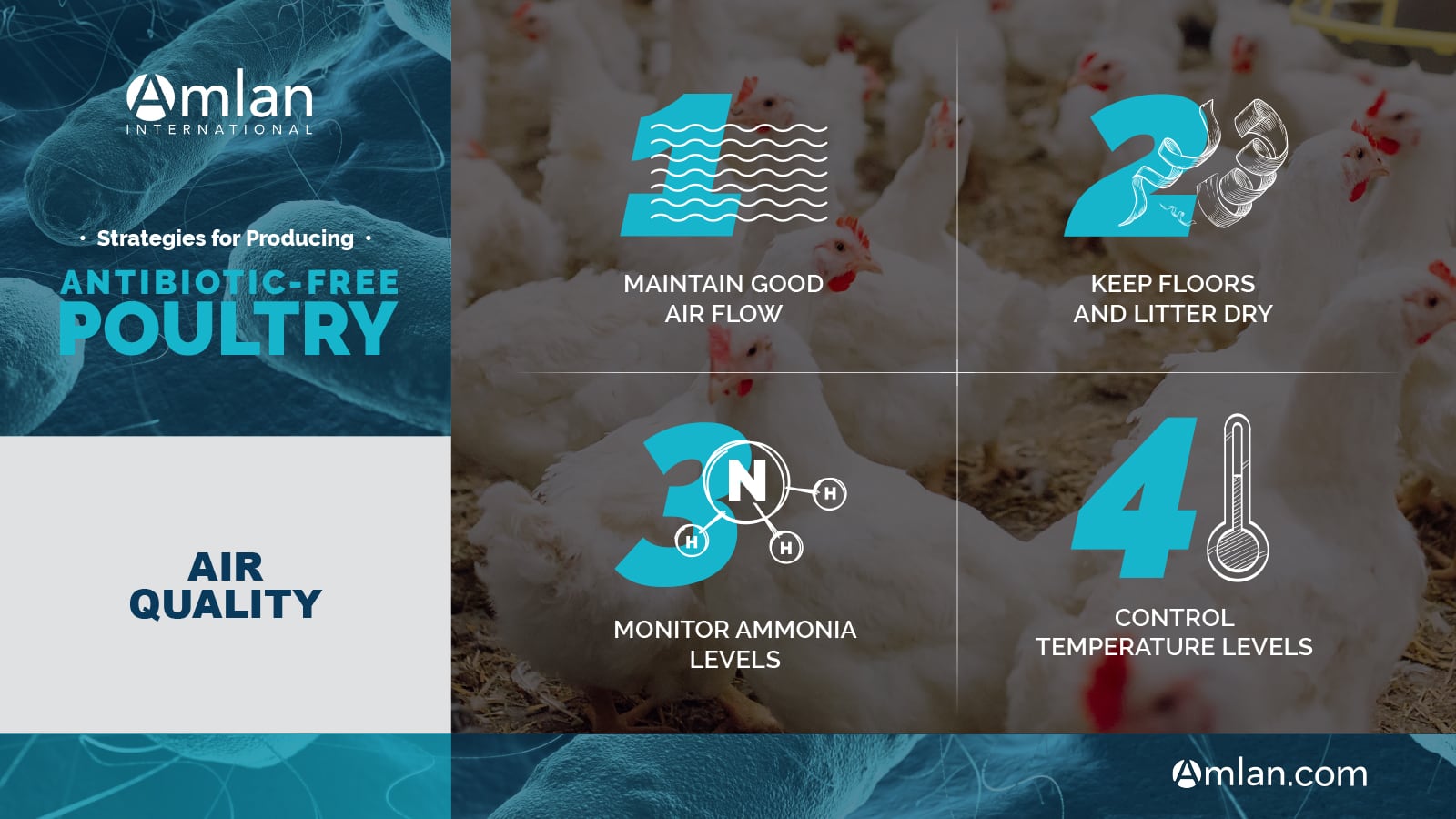An effective poultry house ventilation system is essential for keeping litter dry, ammonia levels low and creating an environment that promotes healthy and efficient birds. This also includes managing the temperature and humidity to keep birds near their thermoneutral zone which will help drive weight gain and maximize feed conversion. Here, we take a closer look at what our industry experts consider air quality best practices for antibiotic-free poultry producers, as part of our series on strategies for producing antibiotic-free poultry.
Achieve Low Moisture and Ammonia Levels
Removing moisture from the poultry house is key for birds that are healthy and performing at their potential. Maintaining air movement, with fresh air coming in and stale air moving out, helps keep the floors and litter dry. As mentioned in our previous post on house environment and biosecurity, dry litter reduces the risk of disease and helps ammonia stay at acceptable levels.
Monitoring ammonia levels is an important factor for protecting bird health. If ammonia levels are too high it can irritate the birds’ nasal passages, trachea and eyes and cause dermatitis in paws, leading to poor performance. To keep birds safe, electrochemical, colorimetric or dosimeter tubes are available to monitor ammonia levels. Products can also be added to the litter to help minimize ammonia concentration, but keeping the litter dry (e.g., no leaking water lines) and providing adequate air flow and ventilation are important first steps.
Wet droppings due to poor intestinal health can also contribute to increased moisture and ammonia levels in the litter. Preventing enteric diseases, such as coccidiosis and necrotic enteritis, can help reduce the occurrence of diarrhea or wet droppings. Enteric diseases were traditionally controlled by antibiotics, but with the increase in antibiotic free production, natural alternatives are now available that can help maintain intestinal health and integrity.
Maintain Thermoneutral Zone
Birds should be kept near their thermoneutral zone so that they are not cold or heat stressed and are better able to cope with other stress, such as pathogens in the environment. Controlling air temperature and humidity in the house is a large task as not only does the weather impact them, the birds themselves put out their own BTU which contributes to the overall heat and moisture in the house.
If available, controllers can program fans and heating systems to try to maintain the temperature and humidity within a set range for the birds’ age. However, parts of the ventilation system can break, so it’s important to regularly perform a manual check to ensure everything is functioning correctly.
While it is important to keep birds warm in winter, it is also important that enough fresh air is introduced into the house to keep ammonia and moisture levels low. Once the cold air enters the house, negative pressure should be used to warm the air, then exhaust it, thereby picking up moisture and helping to dry the floor. Producers should consider the most efficient way that this can be achieved in their system.
In hot weather, large fans at the end of the house can push air movement through the house at more than 500 feet/minute. This fast air speed creates a wind chill that can drop the “feels-like” temperature by at least 10 °F. Other methods to keep the birds cool include evaporative cooling cells and foggers which create a fine mist over the birds. These need to be maintained well to avoid creating wet areas in the house. The water used in these systems should be good quality to avoid mineral build-up in the lines causing damage and introducing pathogens to the birds. More information on water quality can be found in our water quality ABF best practices post.
Back-up generators and emergency plans are essential for protecting birds and the farm from disastrous consequences in a power outage. Without adequate ventilation and air movement, the environment inside the house can become dangerous very quickly, in both cold and hot conditions. Houses are usually sealed tight to ensure efficient heating/cooling, but this means that humidity and temperature can increase very quickly during power failure, as well as CO2 levels and water vapor from the birds.
Providing an optimum poultry house environment with adequate ventilation, the right temperature and humidity for the birds’ age and low contaminants in the air is key for maximizing bird performance. Amlan is dedicated to developing next-generation technology to help poultry producers keep birds healthy and maintain productivity for life. Check our Education Center for other posts in our ABF production best practices series.





